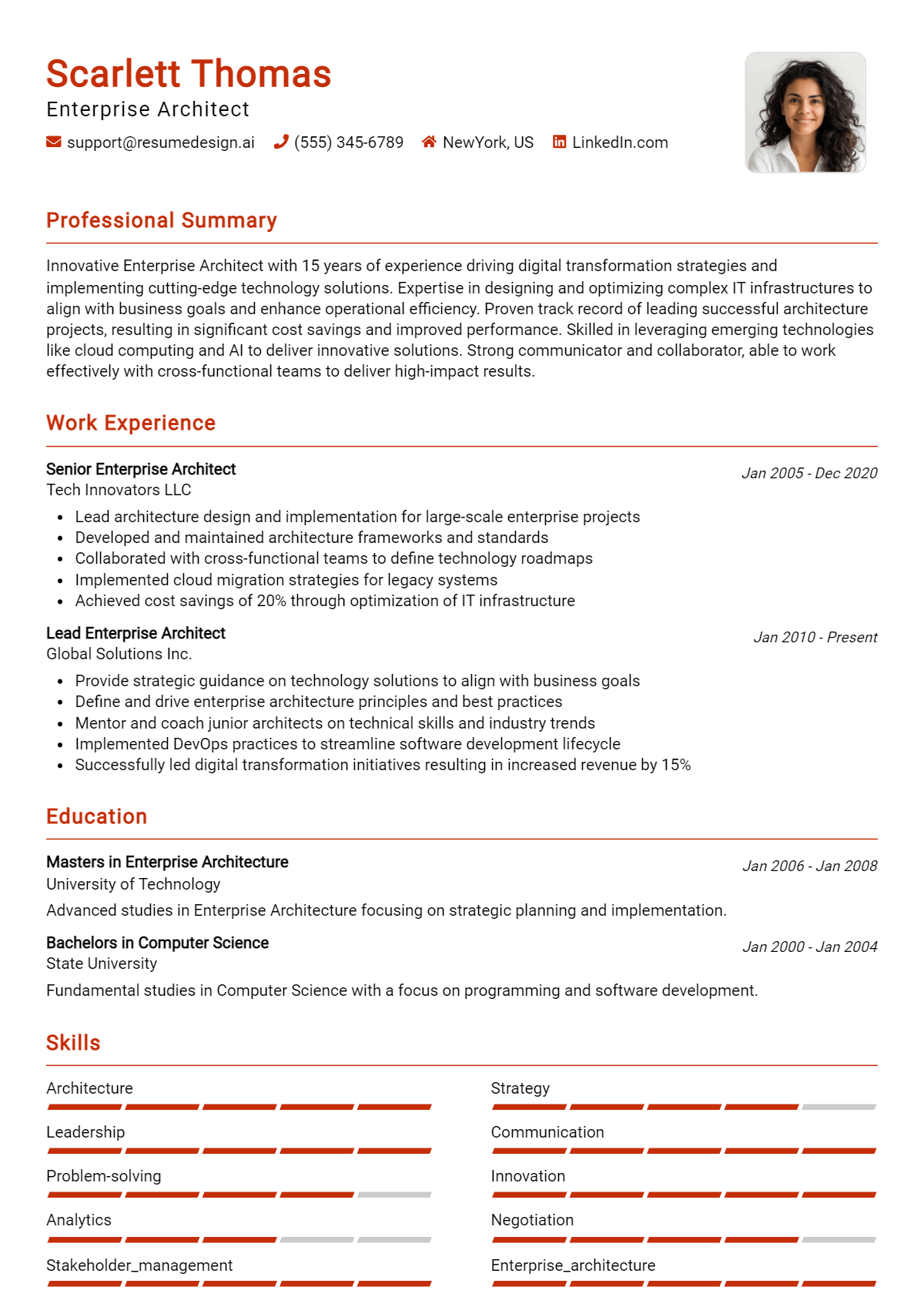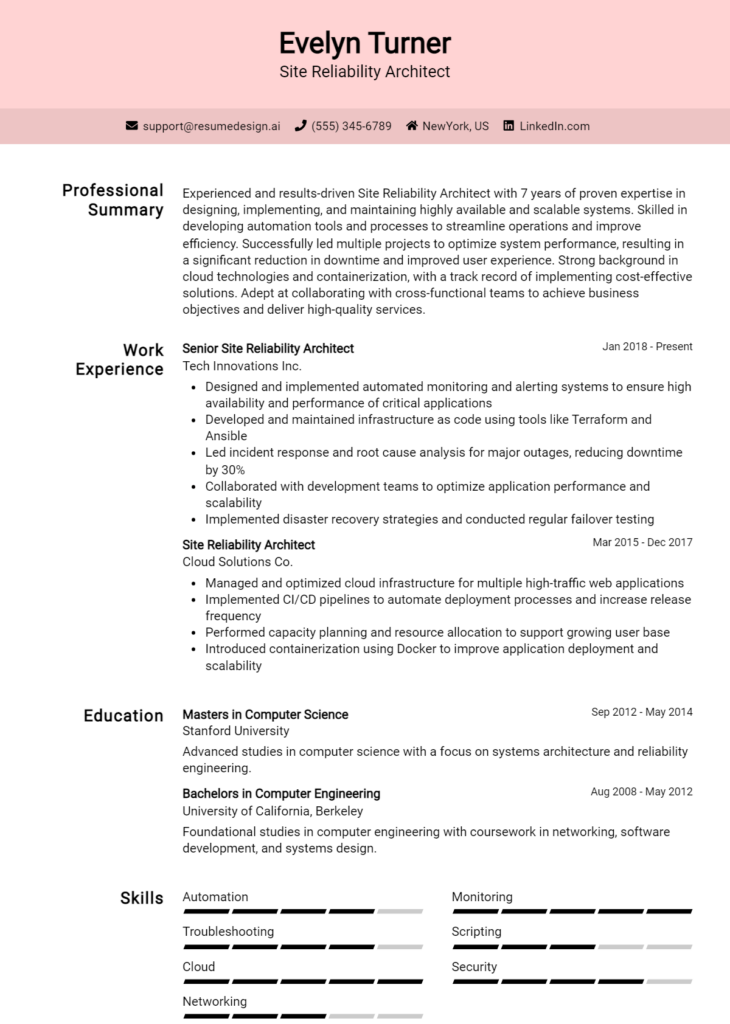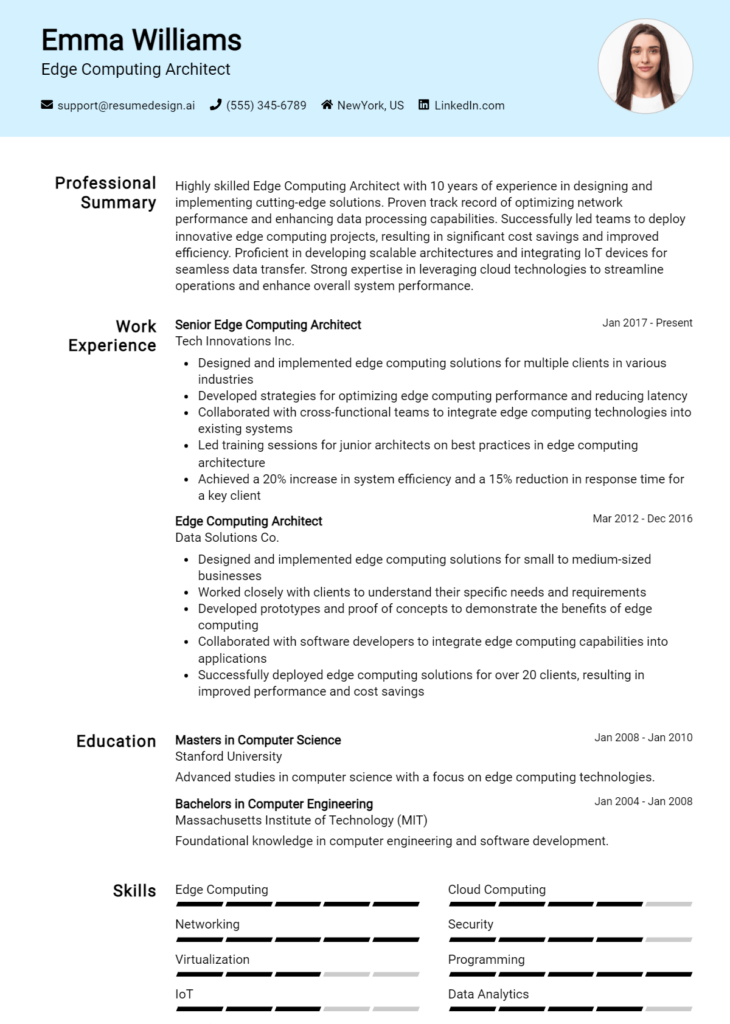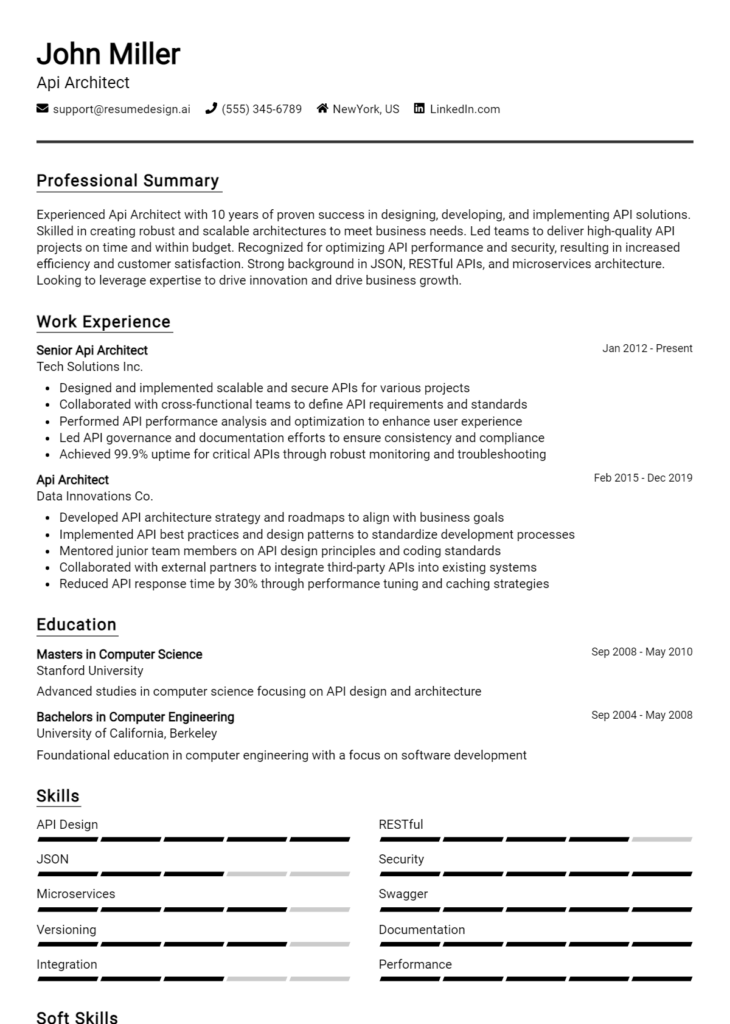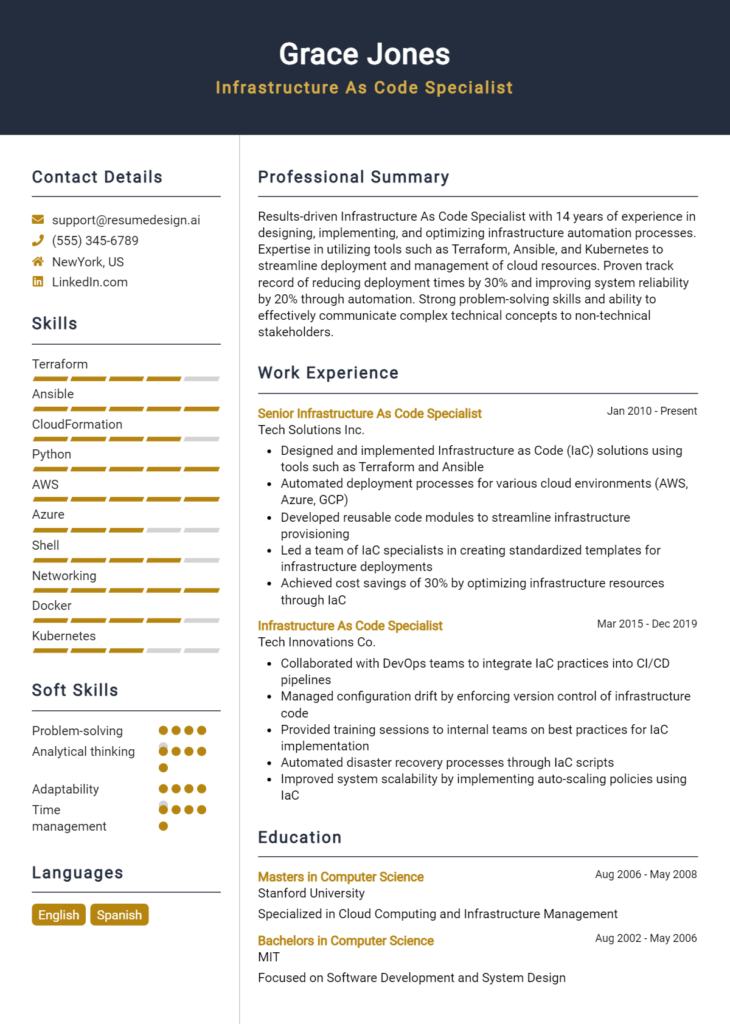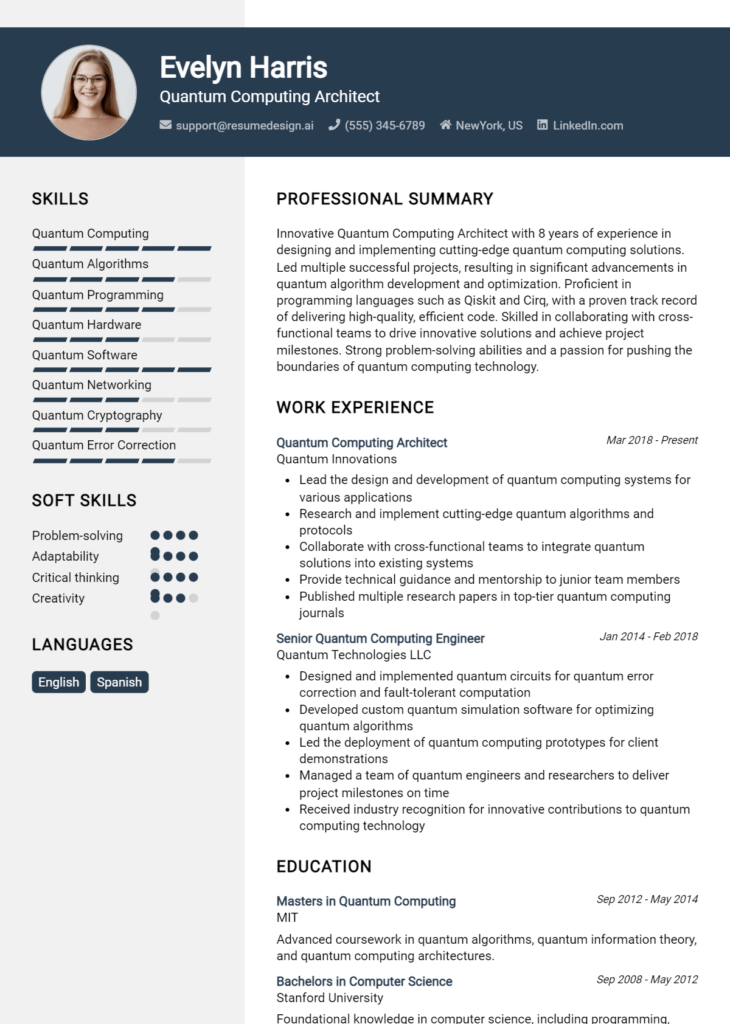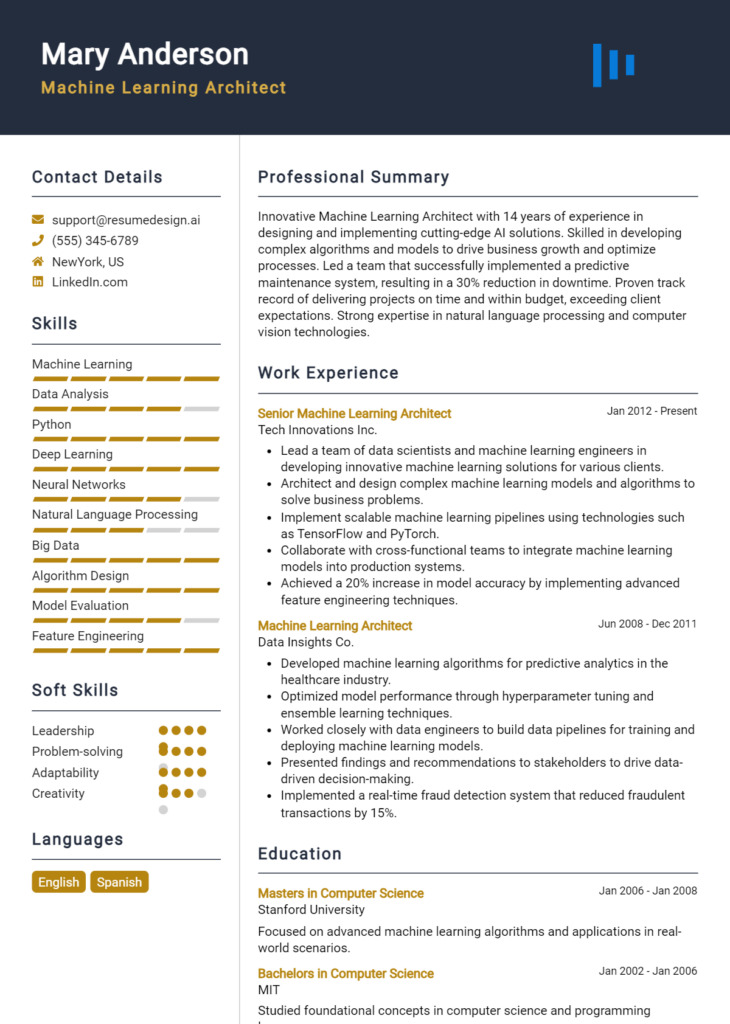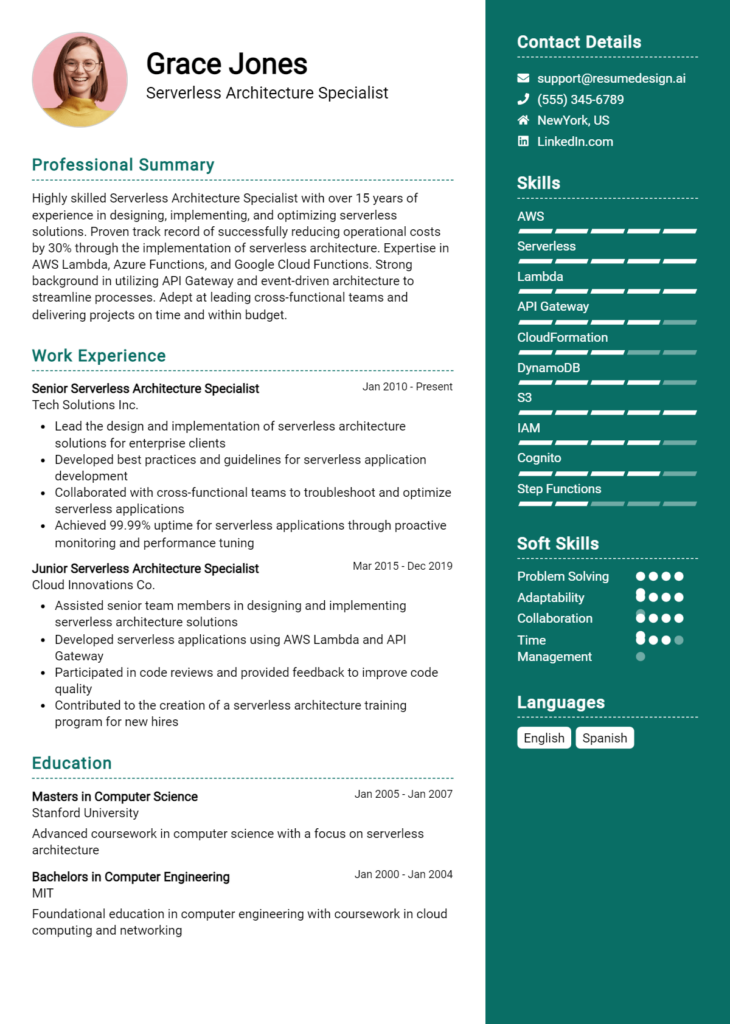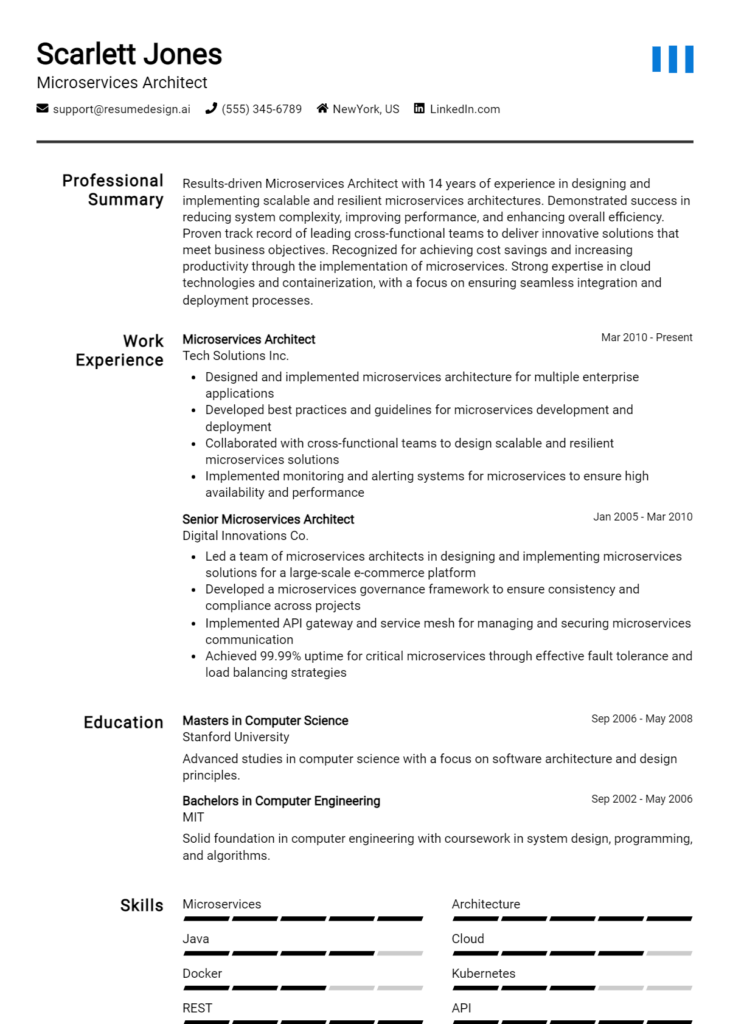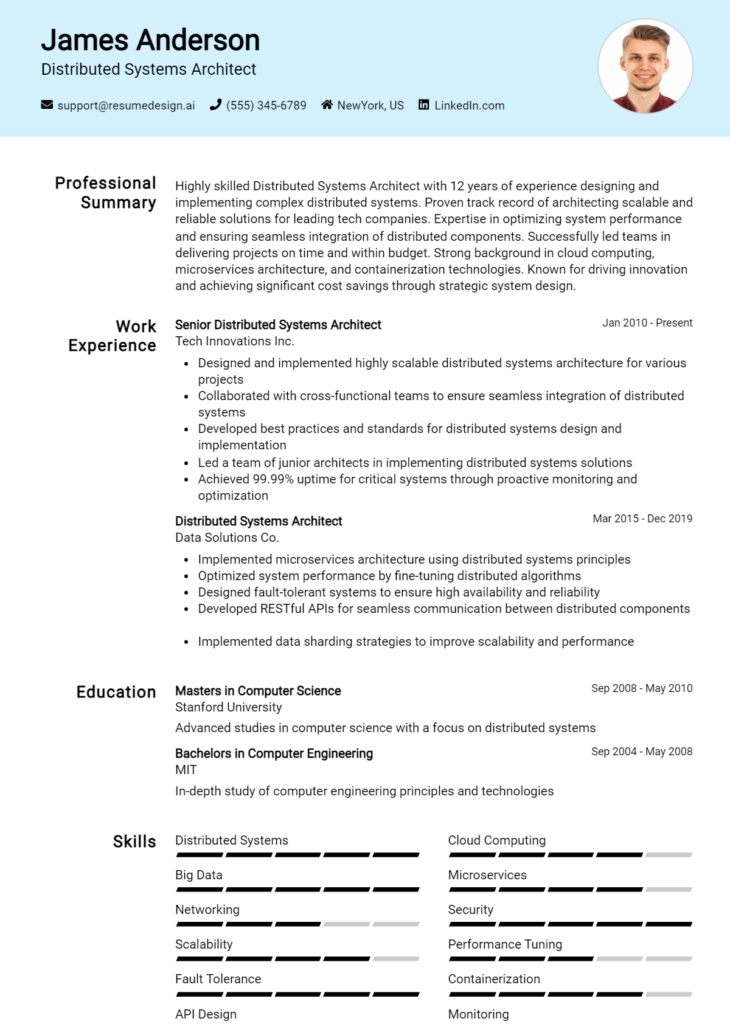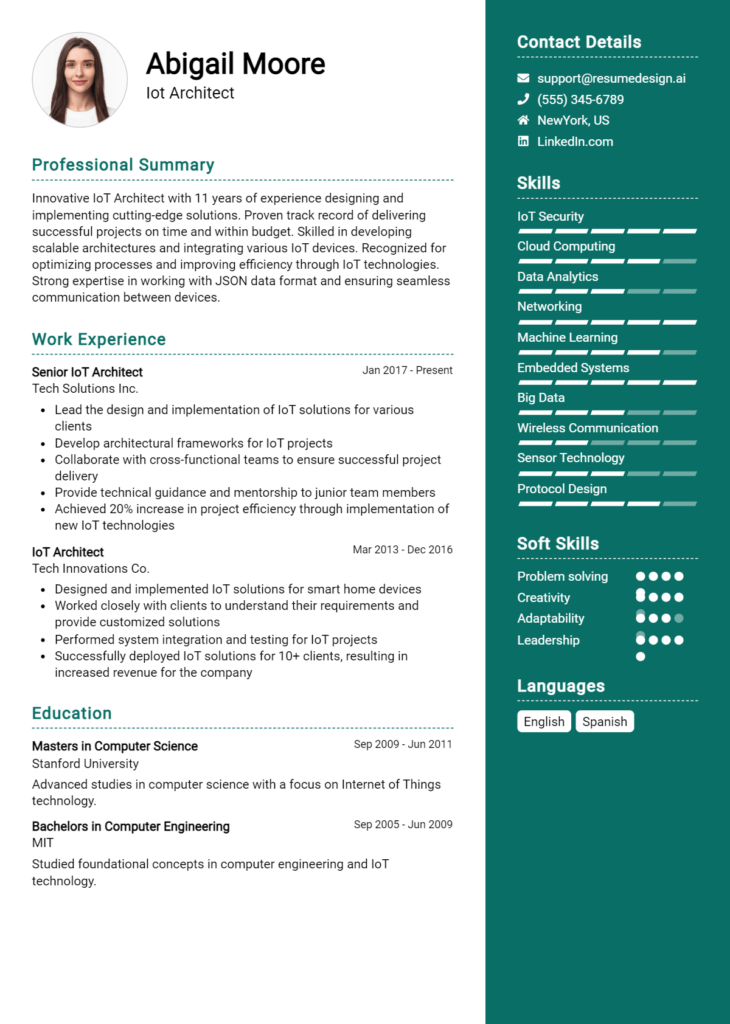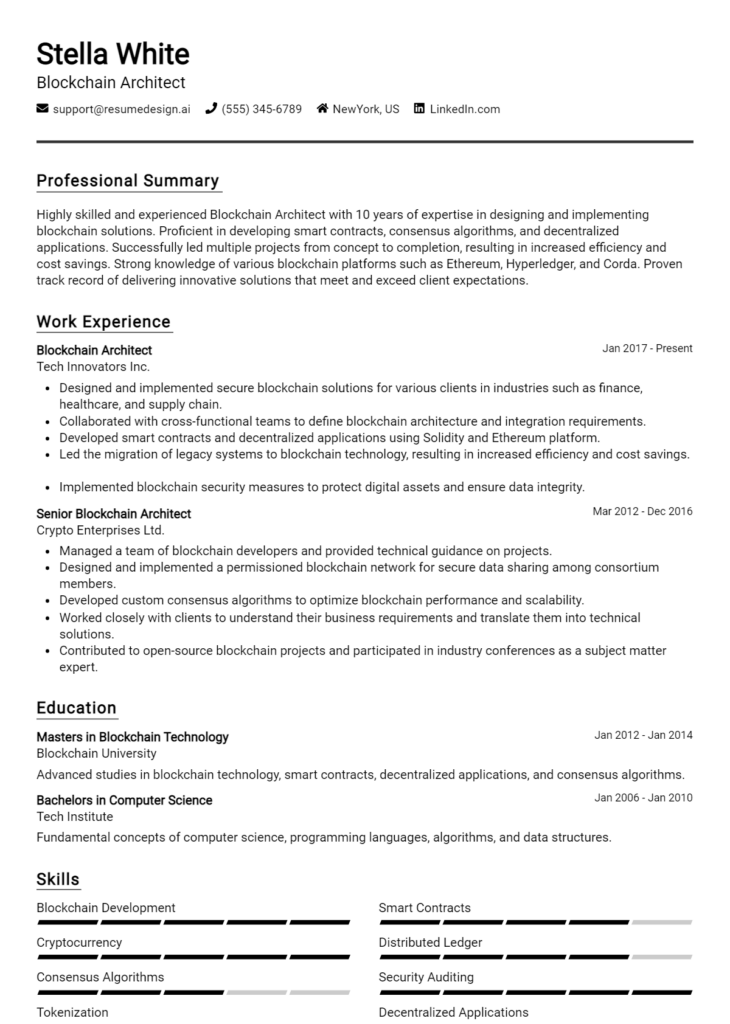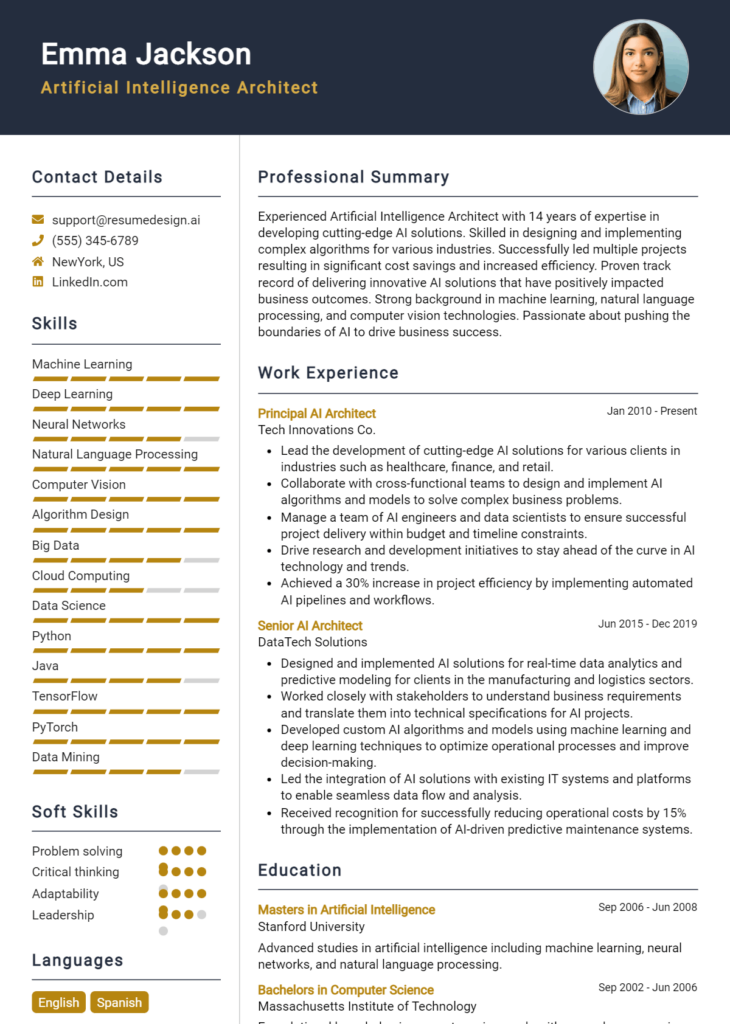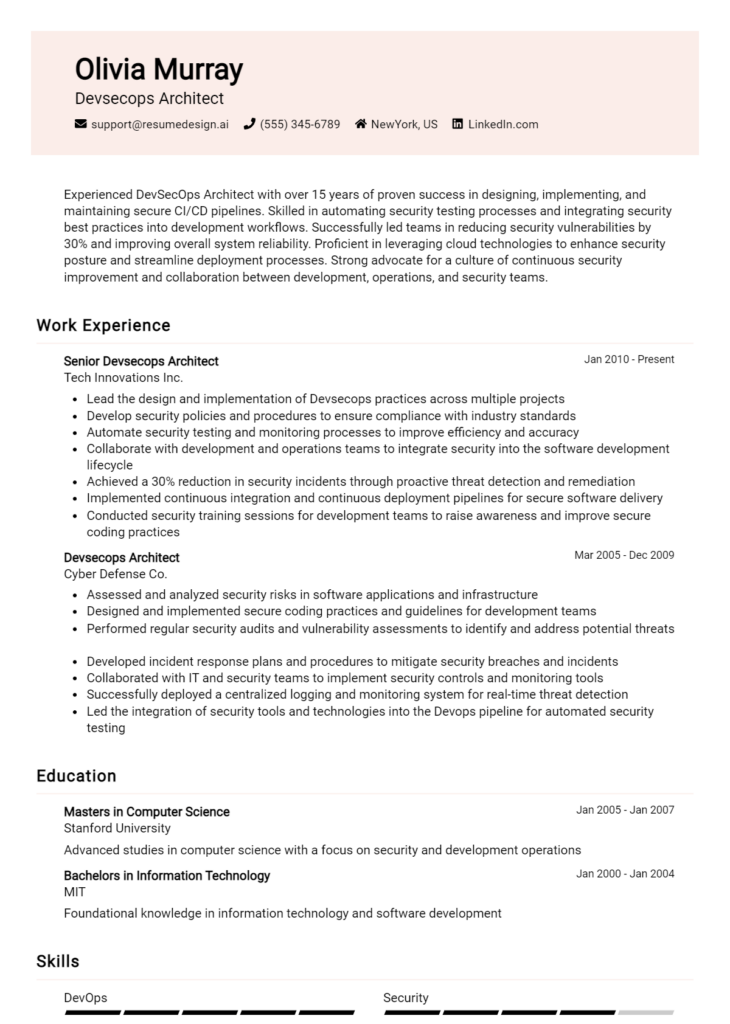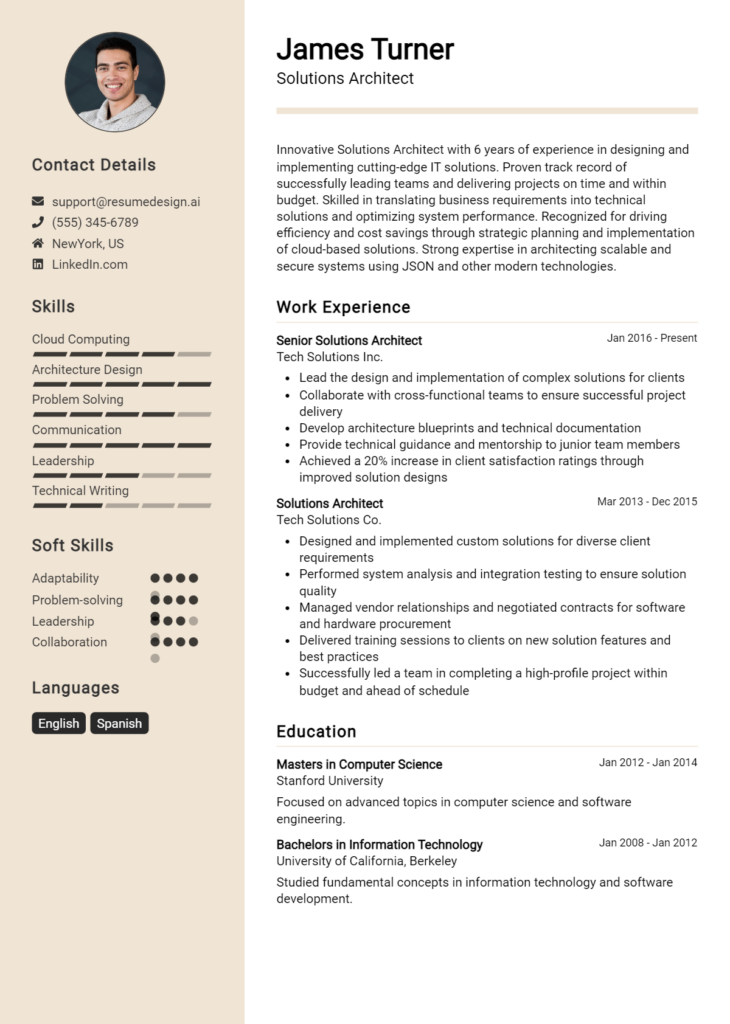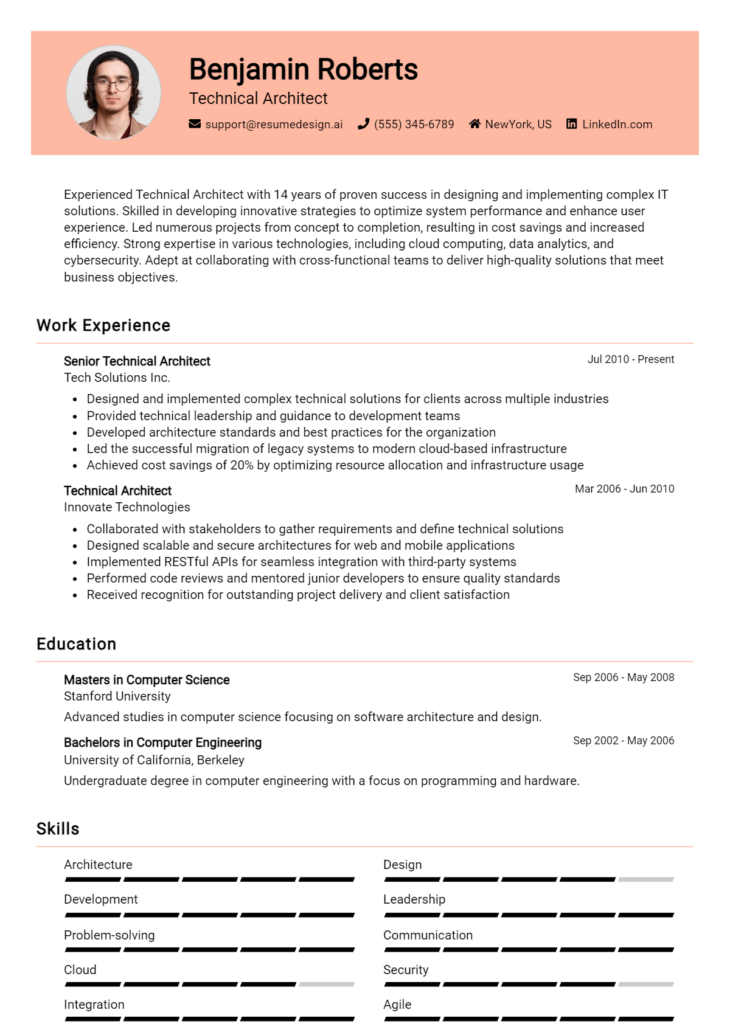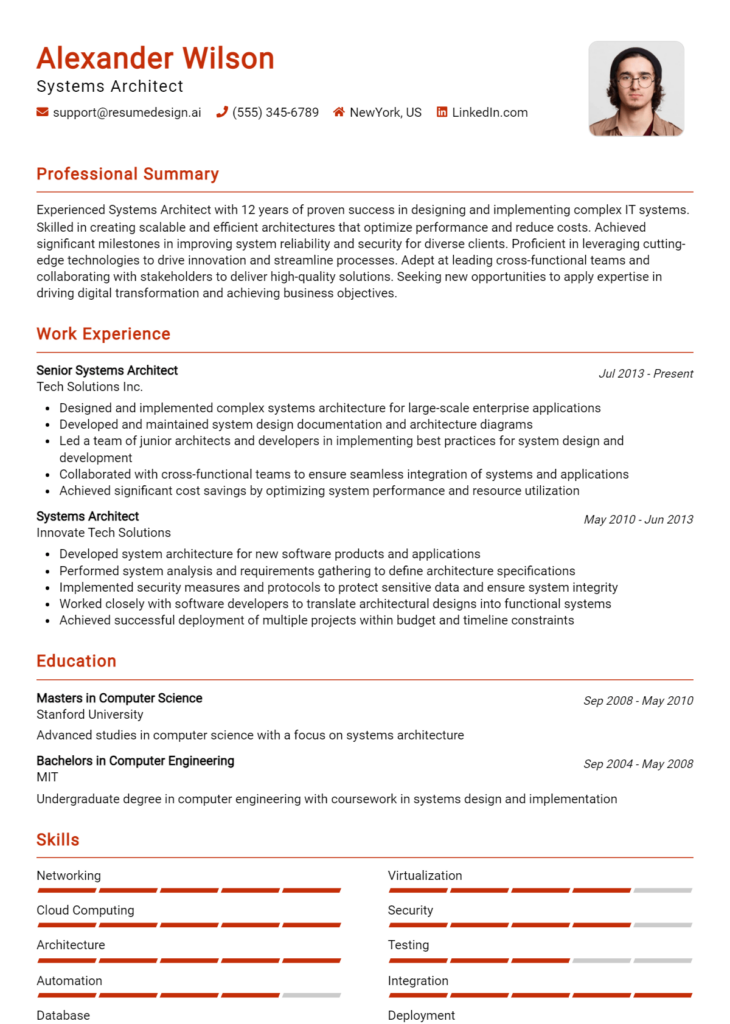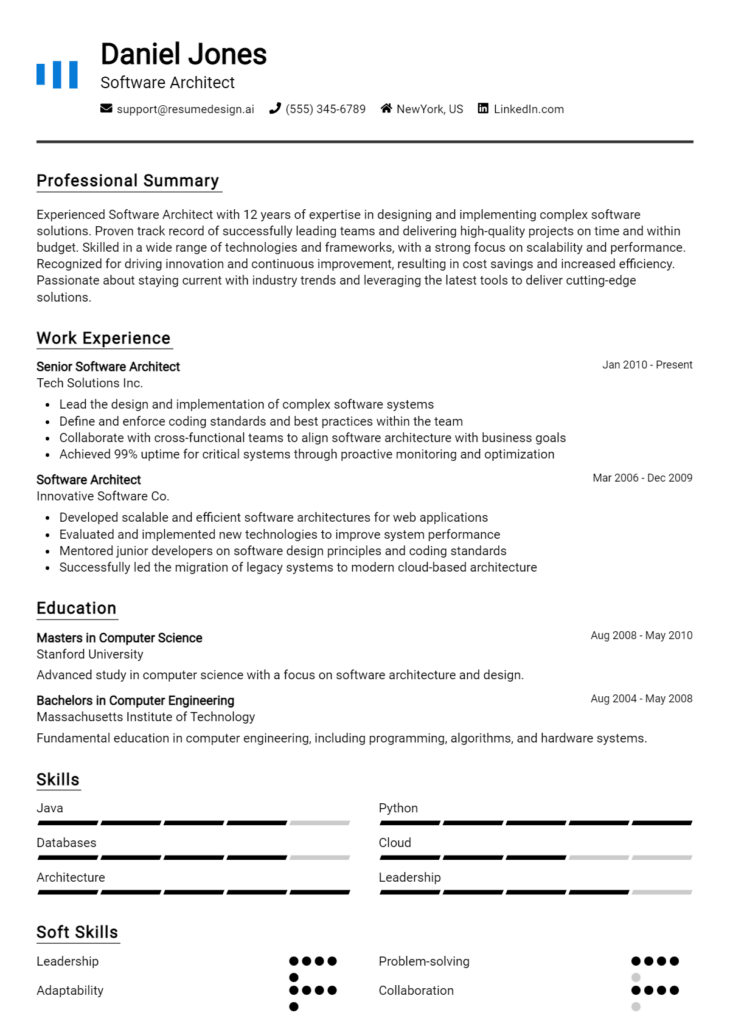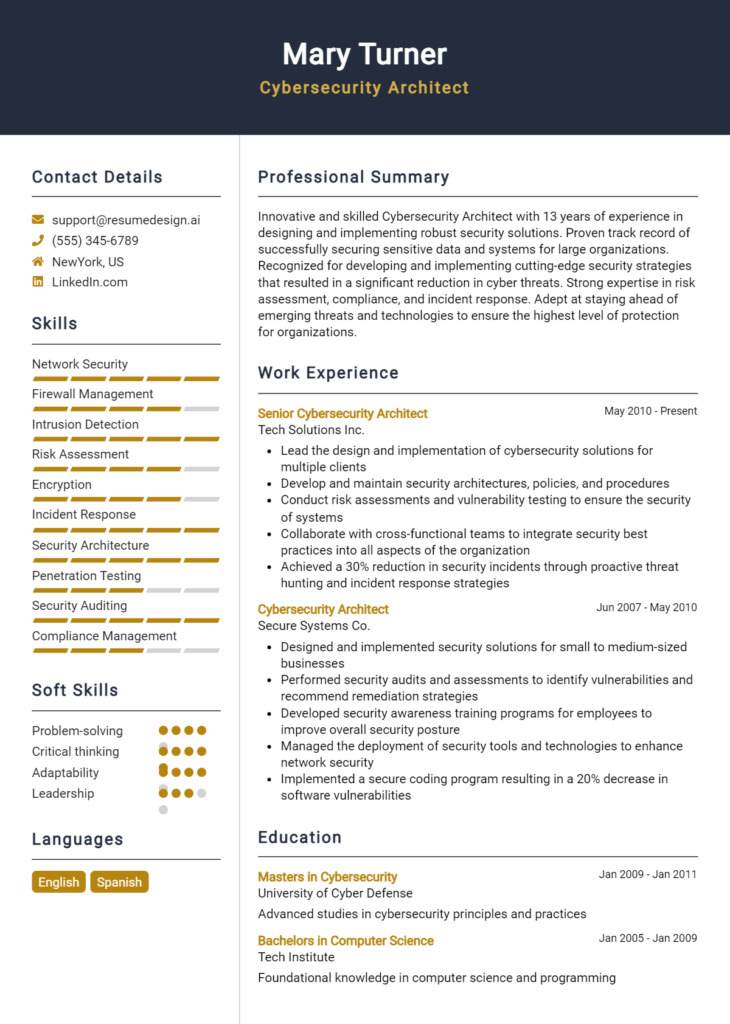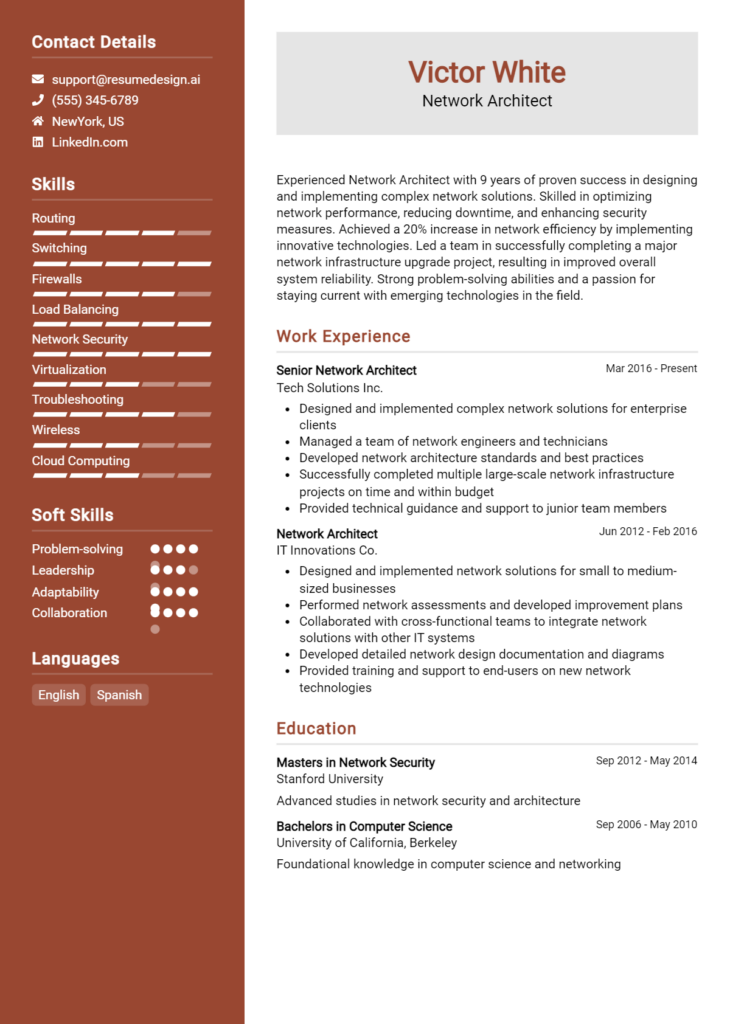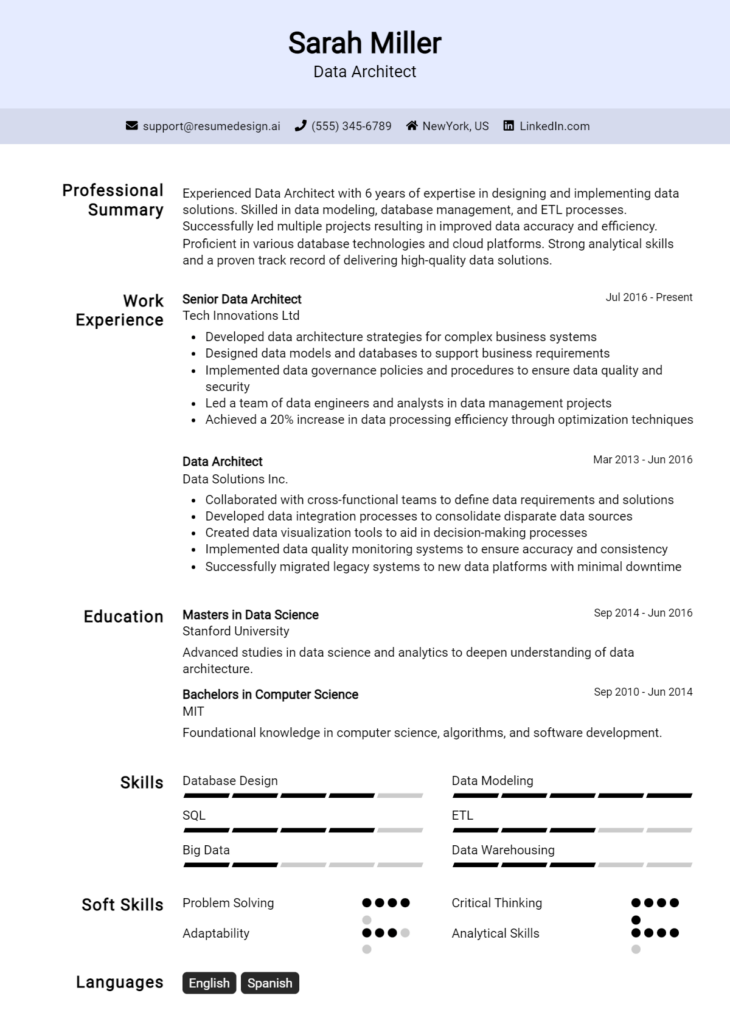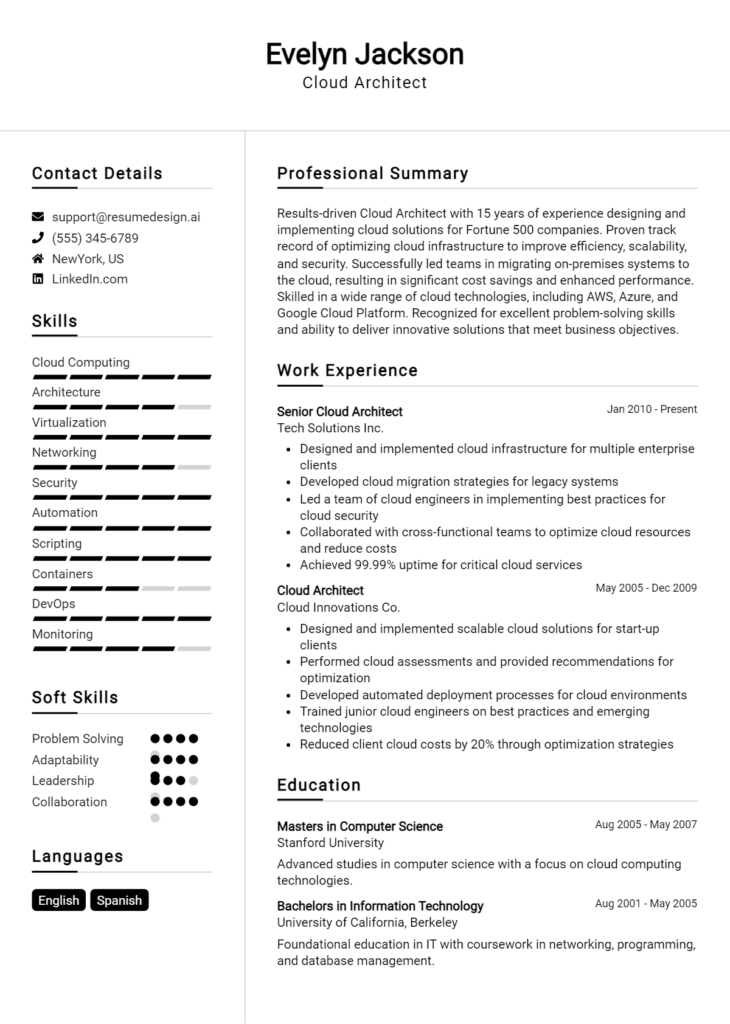Enterprise Architect Core Responsibilities
An Enterprise Architect plays a crucial role in aligning an organization’s IT strategy with its business goals. They bridge various departments by designing and implementing comprehensive architecture frameworks that enhance operational efficiency. Essential skills include technical proficiency, strong problem-solving abilities, and a deep understanding of business processes. These competencies are vital for driving innovation and achieving strategic objectives. A well-structured resume effectively highlights these qualifications, showcasing the candidate's value to prospective employers.
Common Responsibilities Listed on Enterprise Architect Resume
- Develop and maintain enterprise architecture frameworks and models.
- Collaborate with business leaders to define architectural requirements.
- Design solutions that integrate various IT systems and platforms.
- Assess and mitigate risks associated with new technologies.
- Facilitate communication between technical teams and business stakeholders.
- Establish governance processes for technology implementation.
- Lead architecture reviews and ensure compliance with standards.
- Conduct technology assessments and recommend improvements.
- Mentor and guide junior architects and engineering teams.
- Stay updated on industry trends and emerging technologies.
- Support project management by providing architectural insights.
High-Level Resume Tips for Enterprise Architect Professionals
In the competitive field of Enterprise Architecture, a well-crafted resume is crucial for standing out among a pool of qualified candidates. Often the first impression a potential employer has of a candidate, the resume must effectively reflect not only the applicant's skills but also their significant achievements in the field. A compelling resume serves as a strategic marketing tool, showcasing the unique value an Enterprise Architect brings to an organization. This guide will provide practical and actionable resume tips specifically tailored for Enterprise Architect professionals, ensuring that your resume makes a lasting impact.
Top Resume Tips for Enterprise Architect Professionals
- Tailor your resume to the job description by incorporating relevant keywords and phrases that match the specific requirements of the position.
- Highlight your technical proficiency in frameworks, methodologies, and tools that are essential for Enterprise Architecture, such as TOGAF, Zachman, or ArchiMate.
- Showcase relevant experience by detailing projects you've worked on, emphasizing your role in architecture design and implementation.
- Quantify your achievements with specific metrics, such as cost savings, efficiency improvements, or successful project completions.
- Include a summary section that clearly articulates your career objectives and the unique value you bring as an Enterprise Architect.
- Demonstrate your understanding of business needs by linking IT solutions to business outcomes, showcasing your strategic mindset.
- List certifications and ongoing education that pertain to Enterprise Architecture, as they can enhance your credibility and expertise.
- Use a clean, professional format that is easy to read, ensuring that key information stands out to hiring managers.
- Incorporate soft skills like leadership, communication, and collaboration, which are essential for successfully working with diverse teams and stakeholders.
By implementing these tips, you can significantly enhance your resume's impact and increase your chances of landing a job in the Enterprise Architect field. A focused and well-structured resume not only highlights your qualifications but also communicates your strategic vision and alignment with potential employers' needs, making you a standout candidate in a competitive landscape.
Why Resume Headlines & Titles are Important for Enterprise Architect
In the competitive field of enterprise architecture, a well-crafted resume headline or title serves as a critical first impression for candidates. It is the first element that hiring managers see, and a strong headline can immediately grab their attention, succinctly summarizing the candidate's key qualifications and unique value proposition in one impactful phrase. A compelling headline should be concise, relevant, and tailored specifically to the job being applied for, effectively setting the tone for the rest of the resume and encouraging further reading.
Best Practices for Crafting Resume Headlines for Enterprise Architect
- Keep it concise: Aim for one impactful sentence or phrase.
- Be specific: Use terminology and keywords relevant to enterprise architecture.
- Highlight key skills: Focus on your most relevant skills and expertise.
- Showcase achievements: Mention notable accomplishments to demonstrate value.
- Align with job description: Tailor your headline to reflect the specific role you are applying for.
- Avoid jargon: Use clear and accessible language that is easy to understand.
- Include quantifiable metrics: If possible, incorporate numbers to quantify your impact.
- Reflect your career stage: Ensure your title aligns with your level of experience and expertise.
Example Resume Headlines for Enterprise Architect
Strong Resume Headlines
Dynamic Enterprise Architect with 10+ Years of Experience in Driving Digital Transformation.
Results-Oriented Enterprise Architect Specializing in Cloud Solutions and Infrastructure Optimization.
Strategic Enterprise Architect with Proven Track Record in Aligning IT Strategies with Business Goals.
Weak Resume Headlines
Experienced Professional Seeking Job.
IT Specialist Looking for Opportunities.
The strong headlines are effective because they are specific, highlight the candidate's unique qualifications, and immediately convey their value to potential employers. They utilize relevant keywords and clearly state the candidate's experience and focus areas, making them more memorable. In contrast, the weak headlines fail to impress due to their generic nature and lack of specificity—they do not provide any insight into the candidate's skills or value proposition, making it difficult for hiring managers to see why they should consider the applicant for the role.
Writing an Exceptional Enterprise Architect Resume Summary
In the competitive field of enterprise architecture, a well-crafted resume summary serves as a crucial first impression for candidates. This brief yet powerful introduction quickly captures the attention of hiring managers by effectively showcasing key skills, relevant experience, and notable accomplishments specific to the job role. A strong summary not only highlights your qualifications but also aligns them with the requirements of the position, making it easier for recruiters to see your fit for the role. It should be concise, impactful, and tailored to the specific job you are applying for, setting the tone for the rest of your resume.
Best Practices for Writing a Enterprise Architect Resume Summary
- Quantify achievements: Use specific numbers to demonstrate your impact, such as cost savings, efficiency improvements, or project completion timelines.
- Focus on skills: Highlight technical skills and methodologies relevant to enterprise architecture, such as TOGAF, SOA, or cloud computing.
- Tailor the summary: Customize your summary for each job application by incorporating keywords and phrases from the job description.
- Be concise: Aim for 2-4 sentences that effectively communicate your value without unnecessary fluff.
- Showcase leadership: Mention any experience in leading teams or projects, demonstrating your ability to guide and influence others.
- Include industry experience: Reference your experience within specific industries, which can help establish your credibility and relevance.
- Highlight certifications: If you hold relevant certifications, such as AWS Certified Solutions Architect or Certified Information Systems Security Professional (CISSP), include them to bolster your qualifications.
Example Enterprise Architect Resume Summaries
Strong Resume Summaries
Dynamic Enterprise Architect with over 10 years of experience in designing and implementing scalable IT solutions, resulting in a 30% reduction in operational costs for Fortune 500 clients. Proficient in TOGAF and cloud technologies, with a proven track record of leading cross-functional teams to drive business transformation.
Results-oriented Enterprise Architect with expertise in enterprise integration and system optimization, having successfully led multiple projects that enhanced system performance by 25%. Strong communicator with a focus on aligning IT strategies with business goals to deliver measurable outcomes.
Innovative Enterprise Architect with a decade of experience in managing complex IT landscapes, driving a 40% increase in project delivery efficiency through the implementation of agile methodologies. Skilled in stakeholder engagement and strategic planning, ensuring alignment of technology initiatives with organizational objectives.
Weak Resume Summaries
Experienced IT professional with a background in enterprise architecture looking for new opportunities.
Enterprise Architect with knowledge of various technologies and methodologies. Seeking to contribute to a team in a challenging environment.
The examples labeled as strong summaries stand out due to their specificity, quantifiable achievements, and direct relevance to the enterprise architect role. They clearly communicate the candidate’s value and professional experience, making them compelling. In contrast, the weak summaries are vague, lacking detail and measurable outcomes, which diminishes their impact and fails to capture the attention of hiring managers effectively.
Work Experience Section for Enterprise Architect Resume
The work experience section of an Enterprise Architect resume is critical as it serves as a testament to the candidate's technical prowess and leadership capabilities. This section not only highlights the candidate's ability to manage diverse teams and projects but also showcases their proficiency in delivering high-quality products that meet industry standards. By quantifying achievements and aligning past experience with current industry trends, candidates can effectively demonstrate their value to potential employers, making this section a pivotal part of their resume.
Best Practices for Enterprise Architect Work Experience
- Focus on quantifiable results: Use metrics to demonstrate the impact of your work, such as cost savings, efficiency improvements, or successful project completions.
- Highlight technical expertise: Clearly outline technologies, frameworks, and tools you have experience with, emphasizing your proficiency in relevant areas.
- Showcase collaboration: Detail your experience working with cross-functional teams and stakeholders to illustrate your teamwork and communication skills.
- Use action verbs: Start each bullet point with strong action verbs to convey a sense of initiative and results-driven mindset.
- Align with industry standards: Tailor your experience to reflect the skills and competencies that are currently in demand in the enterprise architecture field.
- Include leadership roles: Highlight any leadership positions you have held, showcasing your ability to guide teams and influence organizational decisions.
- Keep it concise: Use clear and concise language to ensure your experience is easy to read and understand at a glance.
- Prioritize relevant experience: Focus on the most relevant roles that align with the job description of the position you are applying for.
Example Work Experiences for Enterprise Architect
Strong Experiences
- Led a team of 10 in the design and implementation of a cloud-based architecture that reduced operational costs by 30% and improved system reliability by 25%.
- Architected a microservices solution that enabled a 40% faster deployment cycle, significantly enhancing the product release timeline and customer satisfaction.
- Collaborated with IT and business units to develop a comprehensive enterprise architecture framework, resulting in a 20% increase in alignment between IT projects and business goals.
- Conducted architecture reviews and assessments that identified critical areas for improvement, leading to a 50% reduction in project delivery times across multiple initiatives.
Weak Experiences
- Worked on various projects related to architecture.
- Involved in team meetings to discuss architecture-related topics.
- Assisted in some cloud initiatives.
- Responsible for general architecture tasks.
The examples listed as strong experiences are considered effective because they provide specific, quantifiable achievements that demonstrate the candidate's impact and leadership in enterprise architecture. They detail concrete outcomes and technical contributions, illustrating the candidate's expertise and ability to drive results. In contrast, the weak experiences lack specificity and measurable outcomes, making them less compelling and failing to convey the candidate's true capabilities or contributions in previous roles.
Education and Certifications Section for Enterprise Architect Resume
The education and certifications section in an Enterprise Architect resume is crucial for showcasing the candidate's academic background and professional development. This section not only highlights relevant degrees and industry-recognized certifications but also emphasizes a commitment to continuous learning—an essential quality in the ever-evolving field of enterprise architecture. By detailing pertinent coursework, specialized training, and accredited certifications, candidates can significantly enhance their credibility and demonstrate alignment with the specific requirements of the job role.
Best Practices for Enterprise Architect Education and Certifications
- Focus on relevance: Include degrees and certifications that are directly applicable to enterprise architecture.
- Be specific: Clearly state the name of the institution, degree earned, and graduation dates.
- Highlight advanced credentials: Prioritize industry-recognized certifications like TOGAF, Zachman, or AWS Certified Solutions Architect.
- Showcase continuous learning: Mention any ongoing education or recent training that demonstrates commitment to professional growth.
- Include relevant coursework: List specific courses that pertain to architecture frameworks, design methodologies, or technology management.
- Certify your skills: Include any specialized certifications that showcase expertise in specific tools or technologies related to enterprise architecture.
- Use clear formatting: Ensure that this section is well-organized and easy to read, using bullet points and consistent styling.
- Update regularly: Keep this section current with new qualifications or skills acquired over time.
Example Education and Certifications for Enterprise Architect
Strong Examples
- M.S. in Information Systems, ABC University, Graduated May 2021
- TOGAF 9 Certified, The Open Group, Certified January 2023
- AWS Certified Solutions Architect – Associate, Amazon Web Services, Certified March 2022
- Relevant Coursework: Enterprise Architecture Frameworks, Cloud Computing Architecture, IT Strategy and Leadership.
Weak Examples
- B.A. in History, XYZ University, Graduated June 2000
- Certified Microsoft Office Specialist, Certified August 2019
- Basic IT Course, Local Community College, Completed December 2018
- Relevant Coursework: Introduction to Psychology, Creative Writing.
The strong examples are considered effective because they directly align with the skills and knowledge required for an Enterprise Architect role, showcasing advanced and relevant qualifications. In contrast, the weak examples highlight degrees and certifications that do not pertain to enterprise architecture, indicating a lack of focus on the necessary competencies for the position.
Top Skills & Keywords for Enterprise Architect Resume
As an Enterprise Architect, a well-crafted resume is essential for showcasing your expertise and value to potential employers. The skills you highlight can be the deciding factor in whether you land an interview or not. A strong resume should effectively demonstrate a blend of both hard and soft skills, reflecting your technical abilities as well as your interpersonal strengths. Employers look for candidates who not only possess the necessary technical knowledge but also excel in collaboration, communication, and strategic thinking. By focusing on these key skills, you can create a compelling narrative that aligns with the requirements of the role and sets you apart from the competition.
Top Hard & Soft Skills for Enterprise Architect
Soft Skills
- Strategic Thinking
- Communication
- Leadership
- Problem Solving
- Collaboration
- Adaptability
- Critical Thinking
- Stakeholder Engagement
- Negotiation
- Time Management
- Conflict Resolution
- Active Listening
- Team Building
- Emotional Intelligence
- Change Management
Hard Skills
- Enterprise Architecture Frameworks (e.g., TOGAF, Zachman)
- Cloud Computing (AWS, Azure, Google Cloud)
- Systems Design and Integration
- Software Development Lifecycle (SDLC)
- Data Modeling and Management
- Business Process Modeling (BPM)
- IT Governance and Compliance
- Cybersecurity Best Practices
- Agile Methodologies
- Infrastructure Design
- Application Architecture
- Database Management Systems (DBMS)
- Network Architecture
- DevOps Practices
- API Management
- IT Service Management (ITSM)
- Business Intelligence (BI) Tools
For more guidance on how to effectively include these skills in your resume, as well as tips on showcasing your work experience, be sure to explore additional resources.
Stand Out with a Winning Enterprise Architect Cover Letter
Dear [Hiring Manager's Name],
I am writing to express my interest in the Enterprise Architect position at [Company Name] as advertised on [Job Board/Company Website]. With over [X years] of experience in designing and implementing enterprise-level solutions and a proven track record of aligning technology strategies with business objectives, I am excited about the opportunity to contribute to your team. My expertise in enterprise architecture frameworks, cloud computing, and system integration aligns perfectly with the innovative projects your company is undertaking.
In my previous role at [Previous Company Name], I successfully led a cross-functional team to design a comprehensive enterprise architecture strategy that reduced operational costs by [X%] while enhancing system performance and scalability. By collaborating closely with stakeholders, I ensured that our technology roadmap not only met current needs but was also adaptable to future business growth. My strong analytical skills and ability to communicate complex technical concepts to non-technical stakeholders were instrumental in driving organizational buy-in for key initiatives.
What excites me most about the opportunity at [Company Name] is your commitment to leveraging technology to drive business transformation. I am particularly impressed by [specific project or initiative of the company], and I believe that my experience in [specific technology or methodology relevant to the role] would allow me to make a meaningful impact. I am eager to bring my strategic vision and collaborative approach to your team, ensuring that technology serves as a powerful enabler for your business goals.
Thank you for considering my application. I look forward to the possibility of discussing how my background, skills, and enthusiasms can contribute to the continued success of [Company Name]. I am excited about the opportunity to help shape the future of your enterprise architecture and drive innovation within your organization.
Sincerely,
[Your Name]
[Your LinkedIn Profile]
[Your Contact Information]
Common Mistakes to Avoid in a Enterprise Architect Resume
When crafting a resume for the position of Enterprise Architect, it's crucial to present a clear, concise, and impactful document that effectively showcases your skills and experiences. However, many candidates make common mistakes that can undermine their chances of landing an interview. By avoiding these pitfalls, you can enhance your resume's effectiveness and better highlight your qualifications for this critical role in IT strategy and architecture.
Lack of Tailored Content: Failing to customize your resume for the specific job can lead to a generic impression. Always align your skills and experiences with the requirements of the position.
Overly Technical Language: Using jargon or technical terms that are not widely understood can alienate hiring managers. Aim for clarity and ensure that your achievements are communicated in a way that resonates with both technical and non-technical audiences.
Ignoring Soft Skills: While technical expertise is important, neglecting to mention soft skills such as leadership, communication, and collaboration can be a missed opportunity. These skills are vital for an Enterprise Architect who needs to engage with various stakeholders.
Inconsistent Formatting: A cluttered or inconsistent format can make your resume hard to read. Stick to a clean layout with uniform font sizes, bullet points, and headings to enhance readability.
Vague Job Descriptions: Describing your previous roles in vague terms can leave hiring managers unsure of your actual contributions. Use quantifiable achievements and specific examples to demonstrate your impact.
Not Showcasing Relevant Certifications: Enterprise Architects often hold various certifications (like TOGAF, Zachman, etc.). Failing to list these credentials can diminish your credibility. Make sure to highlight any relevant certifications prominently.
Overloading on Technical Skills: While technical skills are essential, listing too many can dilute their impact. Focus on the most relevant skills that align with the job description instead of creating an exhaustive list.
Neglecting the Summary Statement: A weak or absent summary statement can miss an opportunity to grab the recruiter’s attention. Use this section to succinctly highlight your qualifications and career goals, making a compelling case for your candidacy.
Conclusion
In this article, we explored the critical responsibilities and skills associated with the role of an Enterprise Architect. We discussed the importance of aligning IT strategy with business goals, designing scalable and flexible architectures, and ensuring that technology solutions effectively meet organizational needs. Additionally, we highlighted the necessity for strong communication and leadership skills, as Enterprise Architects often serve as a bridge between technical teams and business stakeholders.
To excel in this dynamic role, it's essential to present your qualifications effectively. A compelling resume can be your gateway to landing your desired Enterprise Architect position. Therefore, we encourage you to take a moment to review your Enterprise Architect resume. Ensure it showcases your expertise, experience, and the unique value you bring to potential employers.
To assist you in this process, we recommend utilizing various resources available to enhance your resume. Explore our resume templates to find a design that suits your professional style. If you need a more hands-on approach, try our resume builder to create a tailored document that highlights your skills and achievements. You can also check out resume examples to gain inspiration from successful industry professionals. Don't forget to complement your resume with a strong introduction; our cover letter templates can help you craft an impactful cover letter.
Take action today to elevate your career prospects and ensure your resume stands out in the competitive job market for Enterprise Architects!

